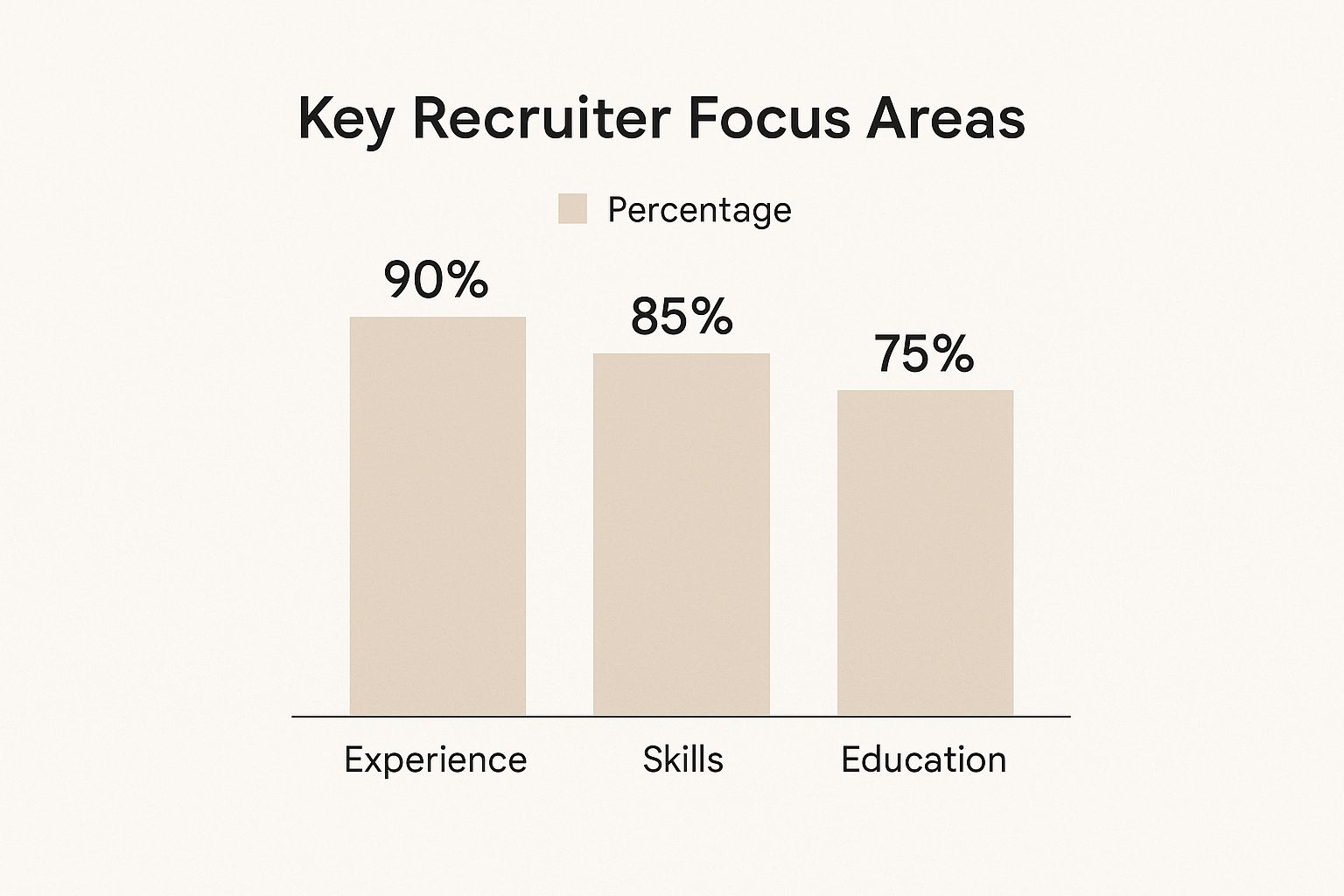
How to Write Resume with No Experience - Tips to Stand Out
Writing a resume when you have zero work experience isn’t about filling a void—it’s about changing the game. You have to pivot from showcasing a timeline of past jobs to painting a vivid picture of your future potential. The secret is to highlight your transferable skills, impressive academic projects, and any volunteer work to prove what you can do for a company, not just what you’ve been paid to do.
Rethinking Your Resume When You Have No Experience
Staring at a blank document, trying to write your first resume, can feel like an impossible task. We’ve all heard the old catch-22: you need experience to get a job, but you need a job to get experience. It’s time to throw that outdated thinking out the window.
The real key to writing a resume with no experience is to stop seeing it as a historical record of paid employment. Instead, think of it as a marketing brochure for you. Modern employers, especially for entry-level roles, are far more interested in what you can actually do, not just where you’ve clocked in and out. This approach completely changes the narrative, shifting the focus from a non-existent work history to a powerful story built on your skills, passion projects, and academic wins.
See your lack of formal job history not as a weakness, but as a clean slate. It’s your chance to build a rock-solid case for why you’re the right person for the job, based purely on your talent and what you’ve already proven you can accomplish.
Prioritize What Recruiters Actually Want
It’s a common myth that the “Work Experience” section is the only part of a resume that gets any attention. While it’s certainly important for seasoned professionals, recruiters today are looking at a much bigger picture for new talent.
In fact, a recent report revealed that 61% of hiring managers are now putting more weight on a candidate’s practical skills than on their years of work history, especially for entry-level positions. This is a huge shift, and it directly acknowledges the challenge new graduates face. You can find more insights on this hiring trend to see just how much it levels the playing field.
Your resume isn’t about proving you’ve held a job; it’s about proving you can do the job. This mental shift is the single most important step in crafting a compelling entry-level resume.
This chart breaks down what recruiters are actually looking for. While experience is still on top, look how closely skills and education follow.

This data is your proof: a resume strategically built around your skills and academic achievements can absolutely hold its own, even without a single paid job on it.
Shifting Your Resume Focus From Experience to Potential
To make this work, you have to adopt a skills-first mindset. This isn’t just about reordering sections; it’s a fundamental change in how you present every piece of information about yourself. Instead of leading with a work history that isn’t there, you’ll lead with tangible proof of your abilities.
This table shows exactly how to reframe your thinking from the old, experience-based model to the new, potential-focused one.
| Traditional Focus (To Avoid) | Modern Skills-First Focus (To Adopt) |
|---|---|
| Chronological list of past jobs. | A showcase of relevant skills and abilities. |
| Job titles and company names. | Project outcomes and demonstrated competencies. |
| Vague descriptions of daily tasks. | Specific, quantifiable achievements. |
| A historical record of employment. | A forward-looking document showing future value. |
| Relies heavily on a “Work Experience” section. | Highlights “Projects,” “Skills,” and “Education.” |
Making this mental switch is the foundation for a standout resume. Every bullet point, every description, and every section should be viewed through this new lens.
Throughout the rest of this guide, we’ll walk through exactly how to build each section of your resume with this new perspective, turning what feels like a disadvantage into your greatest strength: a story of untapped potential.
Structuring Your Resume to Highlight Potential

When you don’t have a traditional “Work Experience” section to lean on, the structure of your resume becomes your single most powerful tool. This isn’t about hiding what you lack; it’s about strategically and confidently showcasing what you have.
Think of your resume less as a historical record and more as a persuasive argument for your potential. Your goal is to guide the recruiter’s eye directly to your strongest qualifications. If they have to hunt for the good stuff, they won’t—they’ll just move on. Let’s build a new foundation that tells a compelling story of competence and drive from the very first line.
Choosing the Right Resume Format
Before you type a single word, you need to pick a layout that works for you, not against you. For anyone figuring out how to write a resume with no experience, the standard chronological format is a non-starter. It’s designed to highlight a career timeline you don’t have yet.
Luckily, you have two much better alternatives.
A fantastic option is the functional resume format. This structure intentionally pushes your work timeline to the background and puts your skills front and center. You can group your abilities into relevant categories like “Digital Marketing” or “Event Coordination,” proving your competence with examples from projects, coursework, and volunteering—not just paid jobs.
Another great choice is the combination (or hybrid) resume. This format blends the best of both worlds, often starting with a powerful skills summary or professional profile. Right after that, you can feature sections like “Relevant Projects” or “Leadership Experience” before getting to your education. It offers the flexibility to put your most impressive qualifications right at the top.
To get a better feel for which one suits you, it’s worth exploring the key differences between a functional vs. chronological resume to see how you can best frame your unique story.
Building Your Resume from the Top Down
Every resume, no matter the format, starts with a clean, professional header. This is non-negotiable and easy to get right.
Make sure your header includes:
- Your Full Name: Use a slightly larger font to make it pop.
- Your Phone Number: Just one reliable number is all you need.
- A Professional Email Address: Something like
[email protected]works perfectly. Ditch the old high school nickname. - Your City and State: You don’t need your full street address anymore.
- A Link to Your LinkedIn Profile or Online Portfolio: This is critical, especially for showcasing projects and creative work.
Directly below your contact info is your first real chance to make an impression: the summary or objective. When you don’t have experience, a resume objective is usually more effective. It pivots the focus from your past to your future, highlighting your career goals and what you aim to contribute.
Pro Tip: Keep your objective short and sweet—three sentences max. Name the role you’re targeting, mention 2-3 of your most relevant skills, and tie it all back to what the company cares about. This simple step shows you’ve done your homework.
Prioritizing Your Most Compelling Sections
This is where the real strategy comes into play. With no “Work Experience” section, you’ll lead with other sections that prove your capabilities. The order is everything. Place your strongest, most relevant section immediately after your resume objective to grab their attention.
Instead of a work history, consider leading with one of these powerful alternatives:
- Projects: Do you have a capstone project from college, a coding assignment you built from scratch, or a detailed research paper? If so, this section should be front and center.
- Relevant Experience: This is a fantastic, flexible heading. It lets you group internships, freelance gigs, volunteer work, and even major roles in student organizations under one strong banner.
- Volunteer Leadership: Did you organize a fundraiser or manage a team for a community cleanup? This is the place to highlight your initiative, teamwork, and organizational skills—all things employers desperately want.
By putting your most impressive achievements at the top, you immediately hook the recruiter and give them tangible proof of your abilities.
After your lead section, you can add other supporting areas to round out your profile. The goal is a logical flow that tells a story.
A smart structure might look something like this:
- Contact Information
- Resume Objective
- Key Projects (or Volunteer Experience, etc.)
- Skills (A dedicated section for both technical and soft skills)
- Education
- Awards and Certifications
This approach flips the traditional resume on its head. It ensures a recruiter sees your hands-on work and valuable skills before they even have a chance to look for a list of job titles. It’s a proactive strategy that turns a potential weakness into a powerful testament to your potential.
How to Uncover and Showcase Your Skills

Let’s be honest: when you don’t have a work history, your skills section isn’t just a part of your resume—it is the resume. It’s the core of your argument, the proof that you bring real value to the table, even before you’ve held a formal job title.
Too many people fall into the trap of listing vague, generic terms like “teamwork” or “good communicator.” That’s not going to cut it. It’s like saying you’re a good cook without ever mentioning a dish you’ve made. Instead, you need to become a skill detective, digging through your life experiences to find solid, undeniable proof of what you can do.
Mining Your Experiences for Hidden Gems
Your life has been preparing you for the workforce, even if it didn’t come with a W-2. The trick is to start looking at your experiences through an employer’s lens. Think about every class project, club leadership role, volunteer gig, or even that complex event you planned for your friends.
Don’t just think about what you did. The real gold is in the how. What problems did you have to solve on the fly? What process did you create to get things done? What was the final result? Answering these questions is how you unearth skills you never even thought to put on a resume.
This approach is more important now than ever. Hiring managers are increasingly looking beyond traditional career paths. A whopping 81% prioritize AI-related skills, and 54% say soft skills are crucial. In fact, 65% of employers are now prioritizing skills over formal degrees. You can discover more insights about these hiring trends to see how this shift can work in your favor.
Translating Academics into Actionable Skills
For the past few years, your education was your full-time job. It’s time to start treating your academic work with the same weight as a professional assignment.
That major group project for your marketing class? It wasn’t just “schoolwork.”
- You call it: A group project.
- A recruiter sees: Project Management. You can say you “Coordinated a team of four to develop a comprehensive marketing plan, managing timelines and delegating tasks to meet a strict deadline.”
That 15-page research paper you slaved over?
- You call it: A final paper.
- A recruiter sees: Data Analysis & Research. Frame it as, “Analyzed over 20 peer-reviewed articles and synthesized complex information to produce a 15-page thesis on renewable energy trends.”
Even your day-to-day coursework demonstrates your work ethic. Hitting every deadline shows you’re reliable. Nailing a high grade in a tough class proves you can learn complex material quickly.
Don’t just list the name of a project. Get specific. Mention your exact role, the tools you used (like SPSS, MATLAB, or even Google Suite for collaboration), and the tangible outcome, like “achieved an A grade” or “presented findings to a panel of 50 students.”
Decoding the Job Description
The single most powerful trick in resume writing is to give the employer exactly what they’re asking for. The job description is your cheat sheet—it’s a literal list of the skills and keywords the company values most.
Seriously, print it out. Go through it line by line with a highlighter and mark every single skill, software, or qualification they mention.
This isn’t just busy work. It does two critical things:
- It builds your keyword list. Most companies use Applicant Tracking Systems (ATS) to scan resumes. If your document doesn’t have the right keywords, a human will likely never see it.
- It tells you what to spotlight. If the posting mentions “data visualization” three different times, you better believe that skill should be front and center in your skills section and woven into your project descriptions.
For example, if the job asks for “strong analytical abilities,” you can connect that directly to your experience analyzing literary themes in an English class or interpreting data sets in a statistics course. It’s all about making that connection for them.
Separating Hard Skills from Soft Skills
A messy, jumbled list of skills is hard to read. By organizing them into hard skills and soft skills, you make it incredibly easy for a recruiter to scan your resume and find what they need in seconds.
Hard skills are the teachable, technical abilities you’ve learned. They are specific and measurable.
You probably have more of these than you think:
- Software Proficiency: Microsoft Office Suite (Word, Excel, PowerPoint), Google Workspace, Adobe Creative Suite
- Programming Languages: Python, Java, HTML/CSS, JavaScript
- Data Analysis: SQL, R, Tableau, Excel (Pivot Tables, VLOOKUP)
- Languages: Spanish (Fluent), French (Conversational)
- Technical Skills: Social media management, SEO basics, content creation
Soft skills, on the other hand, are about how you work. These are your interpersonal traits and are valuable in absolutely any job.
Think about moments you’ve demonstrated:
- Communication: Public speaking, active listening, persuasive writing
- Leadership: Team management, delegation, mentoring, decision-making
- Problem-Solving: Critical thinking, analytical reasoning, creativity
- Work Ethic: Adaptability, time management, attention to detail, organization
When you list these, use clear subheadings like “Technical Skills” or “Interpersonal Skills.” This simple formatting choice shows you’re organized and thoughtful—which is a soft skill in itself. Your goal is to make it effortless for a hiring manager to nod their head and say, “Yes, this person has what we’re looking for.”
How to Describe Your Experience (When You Don’t Have Any)
This is where the magic happens. How you frame your experiences often matters more than the experiences themselves. A hiring manager doesn’t just want a list of things you did; they need to see how you did them and what came of it. This is your chance to turn seemingly minor projects into solid proof of your skills.
Too many people with no formal job history fall into the trap of listing passive tasks. “Wrote a research paper” or “Helped with a bake sale” doesn’t tell anyone a thing about what you’re capable of. We’re going to fix that. It’s time to describe your contributions with the same confidence as someone with years of experience.
Use the STAR Method for Everything
You’ve probably heard of the STAR method for interviews, but it’s an absolute game-changer for writing your resume bullet points, too. It stands for Situation, Task, Action, and Result. Even if you’re just talking about a school project or volunteer gig, this framework helps you tell a compelling story.
Here’s how to put it into practice:
- Situation: Set the scene, but keep it brief. (e.g., “For a final project in my Marketing 201 course…”)
- Task: What was your specific mission? (e.g., ”…I was assigned to create a social media launch plan for a local nonprofit.”)
- Action: What did you actually do? Get specific and use strong verbs. (e.g., “I researched the target audience, analyzed competitor channels, and built a three-week content calendar…”)
- Result: What was the outcome? This is where you add the proof. (e.g., “…which resulted in a 15% lift in post engagement and earned an A on the project.”)
See what happened there? A simple school assignment just became a mini case study showcasing your ability to deliver real results.
Turn Vague Statements into Hard Evidence
The single best way to make your descriptions pop is to add numbers. Quantifying your accomplishments gives a recruiter concrete proof of your impact. Even if no money changed hands, you can almost always find a metric that matters.
Let’s look at a couple of “before and after” examples to see the difference.
Before:
- Member of the university debate club.
This is a classic resume-killer. It’s passive and says nothing about what you contributed.
After:
- Collaborated with a team of four to research and construct compelling arguments for bi-weekly debate tournaments.
- Presented persuasive arguments to audiences of over 50 students and faculty, honing my public speaking and critical thinking abilities.
- Contributed to the team’s 75% win rate over the academic year.
Now, that “after” version screams teamwork, research, public speaking, and a track record of success—all from a student club.
Never discount your non-work achievements. Did you manage a student group’s $500 budget? That shows financial responsibility. Did you organize a charity car wash for 30 people? That’s project management. Find the numbers and put them to work.
Kick Off Every Bullet Point with an Action Verb
Start every single bullet point with a powerful action verb. This simple trick instantly makes your resume feel more dynamic and professional. It shifts the entire focus from what you were “responsible for” to what you actually achieved.
Get rid of weak phrases like “Helped with” or “Tasked with.” Lead with verbs that show you’re a doer.
For Leadership & Management
- Coordinated
- Delegated
- Organized
- Oversaw
- Planned
For Communication & Teamwork
- Collaborated
- Presented
- Negotiated
- Authored
- Advised
For Research & Analysis
- Analyzed
- Evaluated
- Investigated
- Synthesized
- Researched
This isn’t just a stylistic choice; it fundamentally reframes your experience. From the very first word, you position yourself as an achiever.
Tie Your Descriptions Back to Your Objective
Every bullet point on your resume needs to have a purpose. It should directly support the claims you made in your resume objective and align with the job you’re applying for. If your objective says you’re a “detail-oriented problem-solver,” your descriptions better back that up.
For example, don’t just say you ran a blog. Connect it to your career goals.
Example for a Content Marketing Role:
- Independently launched and managed a personal blog on sustainable fashion, growing the audience to over 1,000 monthly visitors within six months.
- Authored and edited 20+ articles, implementing SEO best practices that improved search engine visibility.
- Designed all brand visuals using Canva and promoted content across social media to build a cohesive and engaging brand voice.
This level of detail provides undeniable proof that you’re ready for a role in digital marketing. To learn more about crafting that all-important intro, check out our guide on how to write the best resume objective statement that grabs a recruiter’s attention. When your descriptions prove what your objective claims, you’ve created a resume that’s impossible to ignore.
Final Touches That Make Your Resume Shine

You’ve done the heavy lifting—turning academic projects and volunteer hours into a compelling story of your potential. But don’t hit “send” just yet. The last 5% of the work is what separates a good resume from one that actually lands an interview.
Think of this as the final inspection. A single, careless mistake can undo all your hard work, so let’s make sure every detail is perfect.
Format for a Six-Second Scan
Let’s be real: recruiters are swimming in resumes. They spend an average of only 6 to 8 seconds on their first look. If your resume is a wall of text or a jumbled mess, it’s going straight to the “no” pile.
On top of that, an estimated 75% of resumes are first filtered by Applicant Tracking Systems (ATS) before a human ever sees them. Poor formatting can get you knocked out of the running automatically. You can read the full research on resume statistics to see just how tough the competition is.
To get past both the robots and the humans, your format needs to be clean and scannable.
- Stick to classic fonts. Think Calibri, Arial, or Times New Roman. Keep the size between 10-12pt for readability.
- Embrace white space. Don’t cram your text to the margins. Use space between sections to create a clean, organized look that’s easy on the eyes.
- Use clear, bold headings. Guide the reader’s eye exactly where you want it to go with headings like “Key Projects,” “Technical Skills,” and “Education.”
Your resume format is your silent handshake. A clean, organized layout signals professionalism and attention to detail before a single word is even read.
A great layout respects the recruiter’s time and gives you a much better shot at getting noticed. For a head start, check out our guide on choosing the perfect ATS-friendly resume template.
Proofread Like Your Career Depends on It (Because It Does)
After staring at the same document for hours, your brain starts playing tricks on you. It knows what a word is supposed to say, so it automatically corrects typos as you read. This makes you the absolute worst person to proofread your own resume.
One simple spelling mistake can be enough for a hiring manager to question your attention to detail and move on to the next candidate. Don’t let that happen.
Smarter Proofreading Strategies:
- Read it backward. Seriously. Start with the last word of your resume and read it one word at a time to the beginning. This forces your brain to look at each word individually instead of glazing over sentences.
- Let a robot read it to you. Use a text-to-speech tool on your computer or phone to have it read your resume aloud. Your ears will catch awkward phrasing and errors your eyes missed.
- Find a fresh pair of eyes. This is non-negotiable. Ask a friend, a professor, or a family member to review it. They’ll spot the mistakes you’ve gone blind to.
Save and Send Like a Pro
You’re almost there. The final step is all about presentation. Always, always save your resume as a PDF.
Why? Because a PDF locks in your formatting. It will look exactly the same whether a recruiter opens it on a Mac, a PC, or their phone. A Word document, on the other hand, can get completely mangled, making you look unprofessional.
Finally, give your file a professional name. “Resume.pdf” is a guaranteed way to get it lost in a folder with a hundred others. A much better approach is FirstName-LastName-Resume.pdf. It’s a small detail, but it shows you’re organized right down to the very last click.
Common Questions About No-Experience Resumes
Even with a solid game plan, staring at that blank page can bring up a lot of nagging questions. It’s completely normal to feel a little lost. Let’s tackle some of the most common worries I hear from people so you can get your resume done with confidence.
These are the typical sticking points that trip up most first-timers. Getting straight answers will help you push past the anxiety and focus on what really matters: showing off your potential.
Should My Resume Be One Page if I Have No Experience?
Yes, 100%. A one-page resume isn’t just a suggestion for someone starting out; it’s the gold standard. Think of it less as a limitation and more as a strategic advantage.
Keeping it to a single page forces you to be ruthless about what you include, highlighting only your most impressive qualifications. Trust me, hiring managers appreciate this. They’re often scanning dozens, if not hundreds, of documents, and a clean, one-page layout lets them see your key strengths in seconds.
The one-page limit is your best friend. It forces you to cut the fluff and present a powerful, focused case for why you’re the right person for the role.
What Do I Put on My Resume if I Genuinely Have Nothing?
I hear this all the time, but it’s almost never true that you have “nothing” to show. The trick is to think more broadly about what actually counts as “experience.” A formal, paid job is just one small part of the picture.
Let’s brainstorm what you’ve actually been doing.
- Academic Projects: Did you code a website for a class, write a killer research paper, or develop a mock business plan? That’s project management and hands-on skill application right there.
- Personal Pursuits: Maybe you run a small blog, manage a social media account for a hobby, or build things in your spare time. That’s content creation, digital marketing, and technical skill.
- Volunteer Work: Have you helped organize a fundraiser or offered your time to a local non-profit? That shows teamwork, community engagement, and event coordination.
Even hobbies can be goldmines for skills. Building a gaming PC shows technical know-how, while leading a raid in an online game demonstrates leadership and strategic thinking. It’s all about reframing those activities into the language employers understand.
Is It Okay to Include High School Information?
This really depends on where you are in your journey. If you’re a freshman in college with very little on your plate yet, then absolutely—list that great GPA, a major award, or your role as team captain.
But be warned: high school info has a very short shelf life. The moment you rack up some university-level projects, join a club, or land a volunteer gig, your high school accomplishments should be the first things you cut. Your resume is prime real estate, and you always want to feature your most recent and relevant achievements.
Feeling stuck? You don’t have to do it all yourself. Jobcamp can instantly create resumes and cover letters built specifically for the job you want. Stop staring at a blank screen and start getting interviews. Create your first personalized resume for free at Jobcamp.

